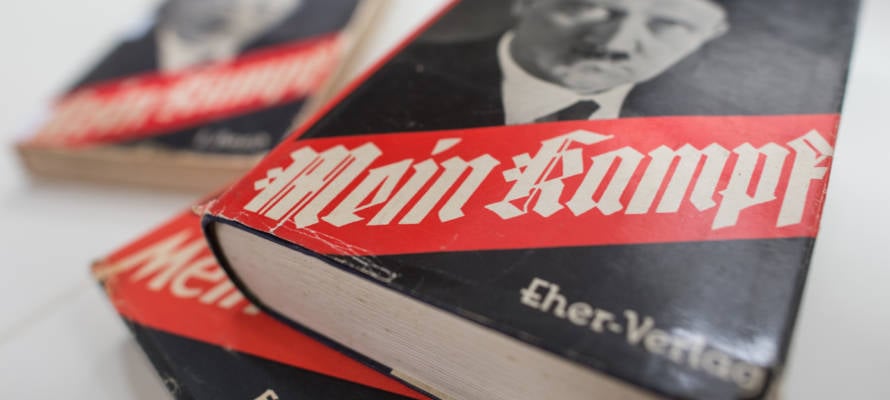By Dr. Rafael Medoff
FDR pledged “the abrogation of all laws and decrees inspired by Nazi governments or Nazi ideologists.” But his public rhetoric apparently didn’t express his private feelings.
Among the more remarkable documents of the Holocaust is a scroll, created in North Africa in 1943, called “Megillat Hitler.” Written in the style of Megillat Esther and the Purim story, it celebrates the Allies’ liberation of Morocco, Algeria, and Tunisia, which saved the local Jewish communities from the Nazis.
What the scroll’s author did not realize, however, was that at the very moment he was setting quill to parchment, those same American authorities were actually trying to keep in place the anti-Jewish legislation imposed in North Africa by the Nazis.
On November 8, 1942, American and British forces invaded Nazi-occupied Morocco, Algeria, and Tunisia. It took the Allies just eight days to defeat the Germans and their Vichy French partners in the region.
For the 330,000 Jews of North Africa, the Allied conquest was heaven-sent. The Vichy regime that had ruled since the summer of 1940 had stripped the region’s Jews of their civil rights, severely restricted their entrance to schools and some professions, confiscated Jewish property, and tolerated sporadic pogroms against Jews by local Muslims.
In addition, thousands of Jewish men were hauled away to forced-labor camps.
President Franklin Roosevelt, in his victory announcement, pledged “the abrogation of all laws and decrees inspired by Nazi governments or Nazi ideologists.”
But there turned out to be a discrepancy between FDR’s public rhetoric and his private feelings.
On January 17, 1943, Roosevelt met in Casablanca with Major-General Charles Nogues, a leader of the new “non-Vichy” regime.
When the conversation turned to the question of rights for North African Jewry, Roosevelt did not mince words: “The number of Jews engaged in the practice of the professions (law, medicine, etc) should be definitely limited to the percentage that the Jewish population in North Africa bears to the whole of the North African population…”
The President stated that his plan would further eliminate the specific and understandable complaints which the Germans bore toward the Jews in Germany, namely, that while they represented a small part of the population, over fifty percent of the lawyers, doctors, school teachers, college professors, etc., in Germany, were Jews.” (It is not clear how FDR came up with that wildly exaggerated statistic.)
Purim-Style Salvation in Global Jewish Communities
Various Jewish communities around the world have established local Purim-style celebrations to mark their deliverance from catastrophe.
The Jews of Frankfurt, for example, would hold a “Purim Vintz” one week after Purim, in remembrance of the downfall of an antisemitic agitator in 1620. Libyan Jews traditionally organized a “Purim Ashraf” and a “Purim Bergel” to recall the rescue of Jews in those towns, in 1705 and 1795, respectively.
The Jewish community of Casablanca, for its part, declared the day of the 1942 Allied liberation “Hitler Purim,” and a local scribe, P. Hassine, created the “Megillat Hitler.” (The original is on display at the United States Holocaust Memorial Museum.)
The seven chapters of the scroll poignantly blend the flavor of the tale of ancient Persia with the amazing stroke of fortune that the Jews of Casablanca had themselves just experienced.
It uses phrases straight from Megillat Esther, such as “the month which was turned from sorrow to rejoicing” and “the Jews had light and gladness, joy and honor,” side by side with modern references such as “Cursed be Hitler, cursed be Mussolini.”
The Jews of North Africa had much to celebrate. But after the festivities died down, questions began to arise. The Allies permitted nearly all the original senior officials of the Vichy regime in North Africa to remain in the new government. The Vichy “Office of Jewish Affairs” continued to operate, as did the forced labor camps in which thousands of Jewish men were being held.
American Jewish leaders were loathe to publicly take issue with the Roosevelt administration, but by the spring of 1943, they began speaking out. The American Jewish Congress and World Jewish Congress charged that “the anti-Jewish legacy of the Nazis remains intact in North Africa” and urged FDR to eliminate the Vichy laws.
“The spirit of the Swastika hovers over the Stars and Stripes,” Benzion Netanyahu, director of the U.S. wing of the Revisionist Zionists (and father of Israel’s current prime minister) charged. A group of Jewish GIs in Algiers protested directly to U.S. ambassador Murphy.
Editorials in a number of American newspapers echoed this criticism.
At first, Roosevelt administration officials dug in their heels. Undersecretary of State Sumner Welles insisted that technically, the region was no longer under Allied military occupation and the U.S. could not dictate how the local government ran things.
“The under secretary of state was perhaps right from a strictly formal viewpoint,” Prof. Michael Abitbol noted in his study of North African Jewry during the Holocaust. “But he was strangely underestimating the immense influence wielded by the United States over North African internal politics.”
Eventually, under the accumulated weight of public protests, the Roosevelt administration made it clear to the local authorities that the anti-Jewish measures needed to be repealed.
The implementation process, however, was painfully slow. In April 1943, the forced labor camps in North Africa were officially shut down, although some of them continued operating well into the summer. The Jewish quotas in schools and professions were gradually phased out.
In May, the racial laws in Tunisia were abolished. Two hundred Italian Jews who had been taken by the Allies to a Tunisian forced labor camp, because they were citizens of an Axis country, were released after several months.
And on October 20, 1943, nearly a year after the Allied liberation, full rights for North Africa’s Jews were at last reinstated. The victory that “Megillat Hitler” celebrated was finally complete.
(Dr. Medoff is director of The David S. Wyman Institute for Holocaust Studies. This piece was written for Purim 2011.)

